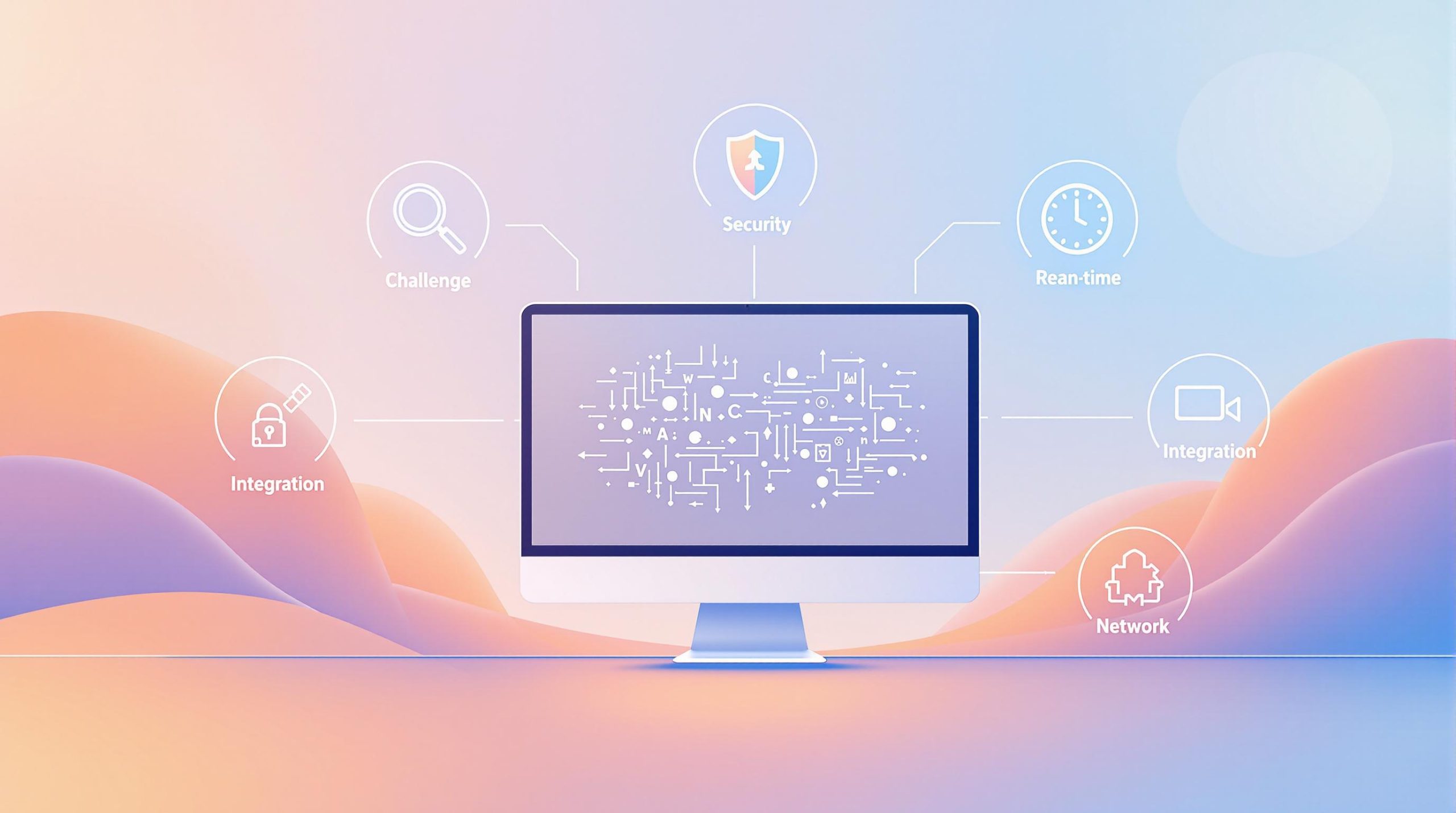Deploying deepfake detection systems is complex and faces significant challenges. Here’s a quick breakdown of the key issues and potential solutions:
- Scalability & Resources: Real-time detection demands high computational power, especially for high-res content. Solutions include lightweight models, edge computing, and frequent updates.
- System Integration: Ensuring compatibility across platforms and media formats is tough. Using platform-agnostic frameworks and optimized designs helps.
- Rapid Deepfake Evolution: Detection accuracy drops as deepfake methods evolve. Multimodal detection and continual learning can address this.
- Lack of Explainability: Detection models often lack transparency. Interpretable models and temporal analysis improve trust and reliability.
- Adversarial Threats: Attackers use anti-forensic techniques to evade detection. Adversarial training and ensemble methods strengthen defenses.
| Challenge | Solution |
|---|---|
| Scalability & Resources | Lightweight models, edge computing |
| System Integration | Platform-agnostic frameworks |
| Rapid Deepfake Evolution | Multimodal detection, retraining |
| Lack of Explainability | Interpretable models, temporal logic |
| Adversarial Threats | Adversarial training, ensemble methods |
Deepfake detection requires constant innovation, collaboration, and investment to stay effective against evolving threats.
Scalable, Person-Agnostic Deepfake Detection In the Wild
1. Scalability and Resource Limitations
Deploying deepfake detection on a large scale comes with a tough balancing act: maintaining accuracy while managing resource demands. Processing and analyzing media in real-time requires enormous computational power, especially when dealing with high-resolution content. This can push standard systems beyond their limits [3].
Compressed media adds another layer of difficulty. It often hides the subtle details that detection models rely on, making it harder for them to spot manipulations effectively [1].
Techniques like model pruning and quantization can help by reducing the size of detection models without sacrificing too much accuracy. These methods are crucial for cutting down resource use. But as deepfake methods evolve, systems need constant updates and retraining, which can stretch resources thin [2].
Real-time detection also demands high-performance infrastructure, which increases operational costs. Organizations must continually invest in upgrades to keep up with new threats [2]. The challenge grows when detection needs to run on devices with limited capacity, all while ensuring speed and accuracy.
On top of these resource issues, integrating detection systems smoothly into existing workflows adds yet another hurdle.
2. System Integration and Compatibility
Integrating deepfake detection systems into existing tech setups comes with its share of challenges. Organizations often struggle to ensure these systems work smoothly across various platforms and handle different types of content.
One major issue is dealing with diverse media formats and compression levels, especially on social media platforms. These variations make it tough to maintain consistent detection performance, particularly when processing content from multiple sources at the same time.
To manage the high volume and speed of media data, detection systems rely on scalable frameworks like Apache Spark or Kafka. While these platforms can handle large data flows, they also add layers of complexity to system design and upkeep.
Another critical concern is platform compatibility. A detection model that works efficiently on high-end servers might falter on mobile devices or edge computing setups. Ensuring these systems perform well across different environments requires tailored technical solutions.
| Platform Type | Key Challenge | Solution |
|---|---|---|
| Mobile Devices | Limited processing power | TensorFlow Lite |
| Edge Computing | Latency issues | Distributed processing |
| Cloud Systems | Scalability | Load balancing |
| Social Media | Format diversity | Multi-format adapters |
Platform-specific performance drops are common, emphasizing the need for cross-platform solutions. For example, edge computing allows real-time detection by processing data near its source, reducing delays and addressing privacy concerns. However, this approach must account for hardware and network limitations.
Using platform-agnostic frameworks and optimized model designs can help close compatibility gaps, but these solutions demand significant time and resources. Organizations must weigh the need for broad system coverage against the practical challenges of implementation.
Even as these integration issues are tackled, the fast pace of deepfake advancements continues to test the limits of detection systems.
sbb-itb-5392f3d
3. Rapid Evolution of Deepfake Techniques
Deepfake technology is advancing so quickly that detection models can lose up to 30% accuracy when faced with newer techniques [1]. Datasets like Celeb-DF, which includes over 5,000 high-quality videos, highlight just how advanced these technologies are becoming [4].
Here are the main challenges detection systems face:
| Challenge | Impact | Suggested Approach |
|---|---|---|
| Data Compression | Accuracy drops by 30% | Better handling of compressed data |
| Dataset Generalization | Struggles with cross-dataset performance | Broader and more diverse training datasets |
| Temporal Consistency | Lower accuracy for full videos | Improved analysis of frame sequences |
One major issue is temporal consistency. Detection models often fail to assess how frames align with each other, which undermines their ability to evaluate videos as a whole [4].
To counter these challenges, multimodal detection methods – which analyze both audio and video – are proving effective. These approaches make detection systems more resilient to the continuous evolution of deepfake methods [1]. Additionally, organizations are turning to continual learning strategies. This helps models adapt to newer techniques while still identifying older ones [1].
Another tactic involves simulating how social media platforms might manipulate content. By training systems under these conditions, organizations aim to make their detection methods more robust [4]. However, many current models still fail to account for frame-to-frame consistency, leaving gaps in their ability to assess video integrity [4].
As these systems work to keep pace with ever-changing deepfake techniques, ensuring they remain transparent and reliable becomes an equally pressing concern.
4. Lack of Clarity and Explainability
Deep learning models often operate like "black boxes", making it hard to understand how they arrive at their decisions. This lack of transparency erodes trust and accountability, especially when these systems fail to explain their outputs. It also complicates error detection and makes it harder to handle new types of deepfakes [1].
| Challenge Area | Impact | Current Solutions |
|---|---|---|
| Decision Process | No clear reasoning behind detections | Use of interpretable models |
| Model Reliability | Hard to verify accuracy | Ensemble learning approaches |
| Error Analysis | Limited insight into false outputs | Temporal pattern analysis |
This lack of clarity creates obstacles for organizations trying to gain stakeholder confidence, comply with regulations, and ensure accountability. The problem becomes even more pronounced when models face unfamiliar deepfakes. Without transparency, it’s nearly impossible to tell if a model is making accurate decisions or just overfitting to its training data.
Multimodal detection methods help address this by identifying mismatched audio and video, offering clearer insights into why content is flagged [1]. Similarly, texture and artifact detection frameworks (TAD frameworks) improve both accuracy and interpretability by pinpointing specific patterns in synthetic media [1].
Temporal logic specifications add another layer of transparency by analyzing patterns across video frames, making it easier to understand flagged content [2]. Context-aware detection, which examines factors like lighting consistency and facial movements over time, provides further explanation for flagged results.
Investing in interpretable models is key to building trust in deepfake detection systems, especially in high-stakes situations where accountability is non-negotiable. However, greater transparency can also make these systems vulnerable to adversarial attacks, as attackers may exploit the very mechanisms designed to improve explainability.
5. Countermeasures and Adversarial Threats
Anti-forensic techniques are designed to hide the telltale signs of synthetic content, making it harder for detection systems to identify manipulated media. These threats not only impact detection accuracy but also make it tougher to deploy reliable systems in practical applications.
| Threat Type | Impact | Techniques |
|---|---|---|
| Anti-forensic & Adversarial Attacks | Masks synthetic content, leads to misclassification | Signal-level manipulation, noise injection, data poisoning |
| Model Vulnerabilities | Reduces detection accuracy | Exploitation of deep learning models |
As detection systems advance, malicious actors find ways to counter them, creating a constant back-and-forth struggle. This ongoing cycle makes it difficult to maintain effective detection methods, especially those relying on static datasets.
"With the increasing effectiveness of DeepFake detection methods, we also anticipate developments of corresponding anti-forensic measures, which take advantage of the vulnerabilities of current DeepFake detection methods to conceal revealing traces of DeepFake videos." [4]
Multi-modal fusion, which examines audio and video together, strengthens detection by forcing attackers to bypass multiple layers of protection. Techniques like ensemble methods and adversarial training add further resilience but require significant computational power [2].
To address these challenges, organizations are adopting various strategies. Lightweight architectures and knowledge distillation are proving useful for balancing security with limited resources [2][3]. Edge computing, combined with adversarial training, also helps deploy stronger detection systems in environments with fewer resources.
Frequency-based methods are showing promise against specific adversarial attacks, while techniques like model pruning and quantization simplify model structures to reduce vulnerabilities [2][3].
As countermeasures continue to develop, staying ahead of adversarial threats is essential to ensure the reliability of detection systems. Constant innovation is needed to keep these systems effective and trustworthy.
Conclusion
This article has covered the key challenges in deploying deepfake detection systems, including issues like scalability, adversarial threats, and resource constraints. Tackling these challenges requires addressing interconnected problems such as evolving attack methods and integration hurdles. Approaches like edge computing, multimodal fusion, and continual learning have shown promise in improving scalability, accuracy, and system flexibility.
Here’s a quick overview of how specific challenges align with potential solutions:
| Challenge | Solution |
|---|---|
| Resource Constraints | Edge computing, lightweight architectures |
| Detection Accuracy | Multimodal fusion |
| Model Flexibility | Continual learning |
Collaboration across the AI community is crucial. As Li et al. point out:
"Deepfake detection methods must improve to handle intentional and adversarial attacks" [4]
This highlights the need for more resilient and flexible detection systems capable of addressing evolving threats.
Future systems will need to strike a balance between being interpretable, efficient, and flexible to address new challenges effectively. Organizations must tailor their strategies to fit their specific requirements, ensuring robust detection without overextending resources.
For those looking to stay informed about advancements in generative AI and its role in deepfake detection, BIFF.ai provides in-depth insights into emerging technologies and their applications in this dynamic field. Staying ahead of these threats will demand not just technical progress but also collaboration across industries and disciplines.

